Proportion and Performance Optimization of Biomass Seedling Trays Based on Response Surface Analysis
Abstract
:1. Introduction
2. Materials and Methods
2.1. Experimental Materials and Equipment
2.2. Experimental Design
2.2.1. Experimental Method
- (1)
- Biomass seedling tray forming experiment
- (2)
- Biomass seedling tray seedling cultivation experiment
2.2.2. Experimental Factors
2.2.3. Performance Evaluation Indexes
2.3. Data Analysis
3. Results
3.1. Orthogonal Experiment
3.1.1. Experiment Results
3.1.2. Variance Analysis and Optimization of Regression Models
3.2. Response Surface Analysis
3.2.1. The Impact of the Factor Interaction on the Bowl Hole Molding Rate
3.2.2. The Impact of the Factor Interaction on the Strong Seeding Index
3.3. Parameter Optimization and Experimental Validation
4. Discussion
4.1. The Impact of the Raw Material Ratio on the Bowl Hole Molding Rate
4.2. The Impact of the Raw Material Ratio on the Strong Seedling Index
4.3. The Advantage of Using Biomass Seedling Trays in Sustainable Development
- (1)
- Environmental protection: Biomass seedling trays are made of degradable organic materials that can naturally decay at the end of their life cycle, reducing environmental pollution. In contrast, traditional seedling trays are mostly made of plastic products that are difficult to degrade, causing serious plastic waste problems.
- (2)
- Resource conservation: Biomass seedling trays use organic waste such as crop straw as the main raw material, which achieves the reuse of waste and also saves limited natural resources. Traditional seedling trays, on the other hand, mainly rely on petrochemical materials such as plastic, which consumes a large amount of non-renewable energy.
- (3)
- Cost reduction: The production material cost of biomass seedling trays is relatively low, and their degradable nature also reduces the cost of disposal and recycling. Traditional seedling trays, on the other hand, have higher production and disposal costs.
- (4)
- Improving seedling efficiency: Biomass seedling trays have good air permeability and moisture retention, which can provide a better growth environment for seedlings, thereby improving the efficiency and quality of seedling production.
- (5)
- Promoting sustainable development of ecological agriculture: The use of biomass seedling trays can reduce the amounts of fertilizers and pesticides used in agricultural production, thereby lowering production costs and environmental pollution. This approach also helps improve the quality and safety of agricultural products and promotes the development of ecological agriculture.
- (6)
- Increasing farmers’ income: The use of biomass seedling trays can reduce farmers’ production costs, increase the added value of agricultural products, and also drive the development of related industries, thereby increasing farmers’ income.
5. Conclusions
- (1)
- This study conducted a multi-factor analysis and response surface analysis on the raw material ratio of biomass seedling trays, investigating the effects of slurry concentration, pulp content, adhesive content, and straw-to-cow manure mass ratio on the molding performance and seedling effect of biomass seedling trays. The primary and secondary order of influence of each factor on the bowl hole molding rate was obtained as follows: adhesive content x3, straw-to-cow manure mass ratio x4, slurry concentration x1, and pulp content x2. The primary and secondary order of influence on the strong seedling index was obtained as follows: slurry concentration x1, straw-to-cow manure mass ratio x4, adhesive content x3, and pulp content x2. The Design-Expert data analysis software was used to establish a regression model between the raw material ratio and the molding performance and seedling effect.
- (2)
- Through optimization and correction of the model, it is known that when the slurry concentration is 30%, the pulp content is 20%, the adhesive content is 530 g, and the straw-to-cow manure mass ratio is 2, the best forming effect and seedling quality of seedling trays can be achieved. At this time, the bowl hole forming rate is 91.03%, and the strong seedling index is 0.22. Through verification experiments, the relative errors between the measured values and the predicted values of the bowl hole molding rate and the strong seedling index are 1.7% and 13.6%, respectively, and these relative errors are small, indicating the high reliability of the model.
6. Forecast
Author Contributions
Funding
Institutional Review Board Statement
Informed Consent Statement
Data Availability Statement
Acknowledgments
Conflicts of Interest
References
- Girona, M.M.; Moussaoui, L.; Morin, H.; Thiffault, N.; Leduc, A.; Raymond, P.; Bosé, A.; Bergeron, Y.; Lussier, J.M. Innovative silviculture to achieve sustainable forest management in boreal forests: Lessons from two large-scale experiments. Boreal For. Face Clim. Chang. 2023, 74, 417–440. [Google Scholar]
- Bose, A.K.; Alcalá-Pajares, M.; Kern, C.C.; Montoro-Girona, M.; Thiffault, N. Complex regeneration responses of eight tree species to partial harvest in mixedwood forests of northeastern North America. For. Ecol. Manag. 2023, 529, 120672. [Google Scholar] [CrossRef]
- Wang, C.; Zhang, X.Z.; Ding, Y.H.; Chen, H.G.; Li, J.F. Research on rice planting machine based on rice straw manufacturing pot seedling tray. Trans. Chin. Soc. Agric. Eng. 2005, 8, 66–69. [Google Scholar]
- Cao, H.L.; Yang, L.Y.; Yuan, Q.X.; Huang, C.Q. Experimental research of seedling substrate compressed of cattle manures. Trans. Chin. Soc. Agric. Mach. 2015, 46, 197–202. [Google Scholar]
- Kuang, S.Z.; Lai, D.; Shao, X.H.; Tian, S.R. Study on light matrix formula of seedling production. Chin. Agric. Sci. Bull. 2017, 33, 124–130. [Google Scholar]
- Sun, E.H.; Huang, H.Y.; Wu, G.F.; Chang, Z.Z.; Xu, Y.D. Mechanical properties of moulding material made from crop stalks and modified UF resin. Trans. Chin. Soc. Agric. Eng. 2014, 30, 228–237. [Google Scholar]
- Tian, M.R.; Gao, J.X.; Liang, H. Preparation and performance of biomass seedling containers made with straw and cow manure. BioResources 2019, 14, 9968–9980. [Google Scholar] [CrossRef]
- Zhu, Q.J.; Wang, X.; Xu, X.H.; Gao, S.; Liu, S.; Chen, H.T.; Zhang, Y. Optimization of manufacturing parameters and experimental study of rice straw fiber-based plant fiber seedling pots. Agronomy 2023, 13, 1782. [Google Scholar] [CrossRef]
- Thonyaporn, S.; Sukanya, S.; Jaruwan, M.; Theera, E.; Kaewta, K. Thermoplastic starch composite with oil palm mesocarp fiber waste and its application as biodegradable seeding pot. Carbohydr. Polym. 2023, 299, 120221. [Google Scholar]
- Li, L.H.; Wang, C.; Zhang, X.Y.; Li, G.Y. Improvement and optimization of preparation process of seedling-growing bowl tray made of paddy straw. Int. J. Agric. Biol. Eng. 2014, 7, 13–22. [Google Scholar]
- Li, L.H.; Wang, C.; Zhang, W. Research on the preparation of rice straw-based phytoplasmic bowl seedling tray. J. Agric. Mech. Res. 2014, 36, 150–155. [Google Scholar]
- Li, L.H.; Wang, C.; Zhang, X.Y. Analysis of the application of phytoplasmic pot seedling trays on rice seedling transplanting. J. Agric. Mech. Res. 2014, 36, 147–152. [Google Scholar]
- Zhang, X.Y.; Wang, C.; Li, L.H.; Zhang, W. Preparation technology and parameters optimization for seedling-growing bowl tray made of paddy straw. Trans. Chin. Soc. Agric. Eng. 2014, 29, 153–162. [Google Scholar]
- Ma, Y.C.; Zhang, W.; Wang, C.; Mao, X.; Zhang, B.; Wang, H.Y. Seedling-growing tray made of rice straw for maize seedling transplantation and its shear mechanics test. Int. J. Agric. Biol. Eng. 2016, 9, 44–55. [Google Scholar]
- Chen, H.G.; Wang, C.; Zhang, W. Development of Rice Planting Machine for Breeding Milk Seedlings in Phytoplasm Bowl. Trans. Chin. Soc. Agric. Eng. 2009, 3, 88–92. [Google Scholar]
- Liu, B. Design and Experimental Research of Rice Pot Seedling Tray Starter. Master’s Thesis, Heilongjiang Bayi Agricultural University, Daqing, China, 2015. [Google Scholar]
- Xie, L.S. Experiment and Research on Rice Plant Mass Bowl Seedling Tray Placement Machine. Master’s Thesis, Heilongjiang Bayi Agricultural University, Daqing, China, 2015. [Google Scholar]
- Zhang, X.Y.; Li, L.H.; Wang, C.; Zhang, W. 2BS-420 rice planting bowl seeding tray precision seeding machine. Trans. Chin. Soc. Agric. Mach. 2013, 44, 56–61. [Google Scholar]
- Yao, J.Y. Plastic Molding Mold Design; Northwestern Industrial University Press: Beijing, China, 2016; pp. 57–63. [Google Scholar]
- Li, H.L.; Wang, C.; Hu, J.; Yu, H.M.; Li, Q.D.; Zhang, X.Y. Simulation and optimum design on airflow distribution chamber of pneumatic molding machine for rice seeding-growing tray. Trans. Chin. Soc. Agric. Mach. 2018, 49, 94–101. [Google Scholar]
- Yu, H.M.; Li, H.Y.; Wang, C.; Li, H.L.; Zhang, X.Y.; Liang, Q.; Yu, B.B. Simulation analysis of flow field uniformity in air distribution chamber of rice tray dryer. J. Agric. Mech. Res. 2020, 42, 15–21. [Google Scholar]
- Yu, H.M.; Wang, C.; Han, Z.X.; Sun, Y.; Hu, J.; Liu, T.X. Optimization of steam drying process for rice phytoplasm bowl seedling trays. Trans. Chin. Soc. Agric. Eng. 2013, 29, 40–49. [Google Scholar]
- Li, H.Y. Study on Microwave Hot Air Combined Drying Technology of Rice Straw Nutrient Bowl Tray. Master’s Thesis, Heilongjiang Bayi Agricultural University, Daqing, China, 2019. [Google Scholar]
- Zhang, J.H.; Lin, Y.J.; Huang, J.; Bai, Z.G.; Sajid, H.; Zhu, L.F.; Cao, X.C.; Jin, Q.Y. Effects of substrate types and uniconazole on mechanized transplanting qualities and grain yield for late rice with different seedling ages. Trans. Chin. Soc. Agric. Eng. 2018, 34, 44–52. [Google Scholar]
- Yang, B.H.; Li, S.; Zhang, G.D.; Zhou, H.X. Biomass environmental friendly rice straw seedling tray seedling technology. Mod. Agric. Sci. Technol. 2018, 21, 42–44. [Google Scholar]
- Molina, E.; Valeria, O.; Martin, M.; Montoro, G.M.; Ramirez, J.A. Long-Term Impacts of Forest Management Practices under Climate Change on Structure, Composition, and Fragmentation of the Canadian Boreal Landscape. Forests 2022, 13, 1292. [Google Scholar] [CrossRef]
- Girona, M.M.; Morin, H.; Gauthier, S.; Bergeron, Y. Challenges for the Sustainable Management of the Boreal Forest Under Climate Change. In Boreal Forests in the Face of Climate Change: Sustainable Management; Springer International Publishing: Berlin/Heidelberg, Germany, 2023; pp. 773–837. [Google Scholar]
- Hof, A.R.; Montoro, G.M.; Fortin, M.J.; Tremblay, J.A. Editorial: Using Landscape Simulation Models to Help Balance Conflicting Goals in Changing Forests. Front. Ecol. Evol. 2021. [Google Scholar] [CrossRef]
- Yao, Z.L.; Zhao, L.X.; Tian, Y.S.; Meng, H.B. Utilization status and medium and long-term forecast of crop straw resource in Heilongjiang Province. Trans. Chin. Soc. Agric. Eng. 2009, 25, 288–292. [Google Scholar]
- Liu, S.; Wang, Y.X.; Liu, Z.D. Application effect of biohythane residue on Brassica and Spinacia seedling production. Trans. Chin. Soc. Agric. Eng. 2014, 30, 225–232. [Google Scholar]
- Doddagoudar, S.R.; Nagaraja, M.; Lakshmikanth, M.; Srininvas, A.G.; Shakuntala, N.M.; Hiremath, U.; Mahanthshivayogayya, K. Improving the resilience of rice seedlings to low temperature stress through seed priming. S. Afr. J. Bot. 2023, 162, 183–192. [Google Scholar]
- Qu, J.S.; Guo, W.Z.; Zhang, L.J.; Feng, H.P.; Yang, D.M. Influence of caragana-straw as nursery substrate on growth and dry matter accumulation of watermelon seedlings. Trans. Chin. Soc. Agric. Eng. 2010, 26, 291–295. [Google Scholar]
- Xia, W.L.; Huang, H.K.; Qi, Z.P.; Wang, Q.S. Experimental studies on dairy manure treatment by static bed composting and microbe reagent inoculating. Trans. Chin. Soc. Agric. Eng. 2006, 22, 215–219. [Google Scholar]
- Zhang, Z.H. Study on Properties of Modified Starch Adhesive and Its Application in Biomass Seedling Trays. Master’s Thesis, Jilin University, Changchun, China, 2021. [Google Scholar]
- Qian, X.Q.; Chen, T.J.; Sheng, K.C.; Shen, Y.Y. Quality characteristics of bamboo charcoal briquette based on corn and cassava starch adhesive. Trans. Chin. Soc. Agric. Eng. 2011, 27, 157–161. [Google Scholar]
- Ma, Y.C. Molding Mechanism and Experimental Research on Seedling-Growing Tray Made of Rice Straw for Maize Seedling Transplantation. Ph.D. Thesis, Heilongjiang Bayi Agricultural University, Daqing, China, 2017. [Google Scholar]
- Lu, K.M. Reserach on the Molding Process and Application Technology of Biomass Seedling Tray. Master’s Thesis, Anhui Science and Technology University, Daqing, China, 2020. [Google Scholar]
- Liu, D.; Teng, D.; Qiu, S.T.; Li, Y.L.; Wang, H.Y. Research on forming characteristics of potted seedling tray prepared from the mixture of corn straw and biogas residue. J. Heilongjiang Bayi Agric. Univ. 2022, 34, 108–115. [Google Scholar]
- Yang, L.Y.; Yuan, Q.X.; Liu, Z.G.; Cao, H.L.; Luo, S. Preparation of aerobic and vermicompost decomposing substrate blocks for cow manure and vermicomposting and seedling nursery trials. Trans. Chin. Soc. Agric. Eng. 2016, 32, 226–233. [Google Scholar]
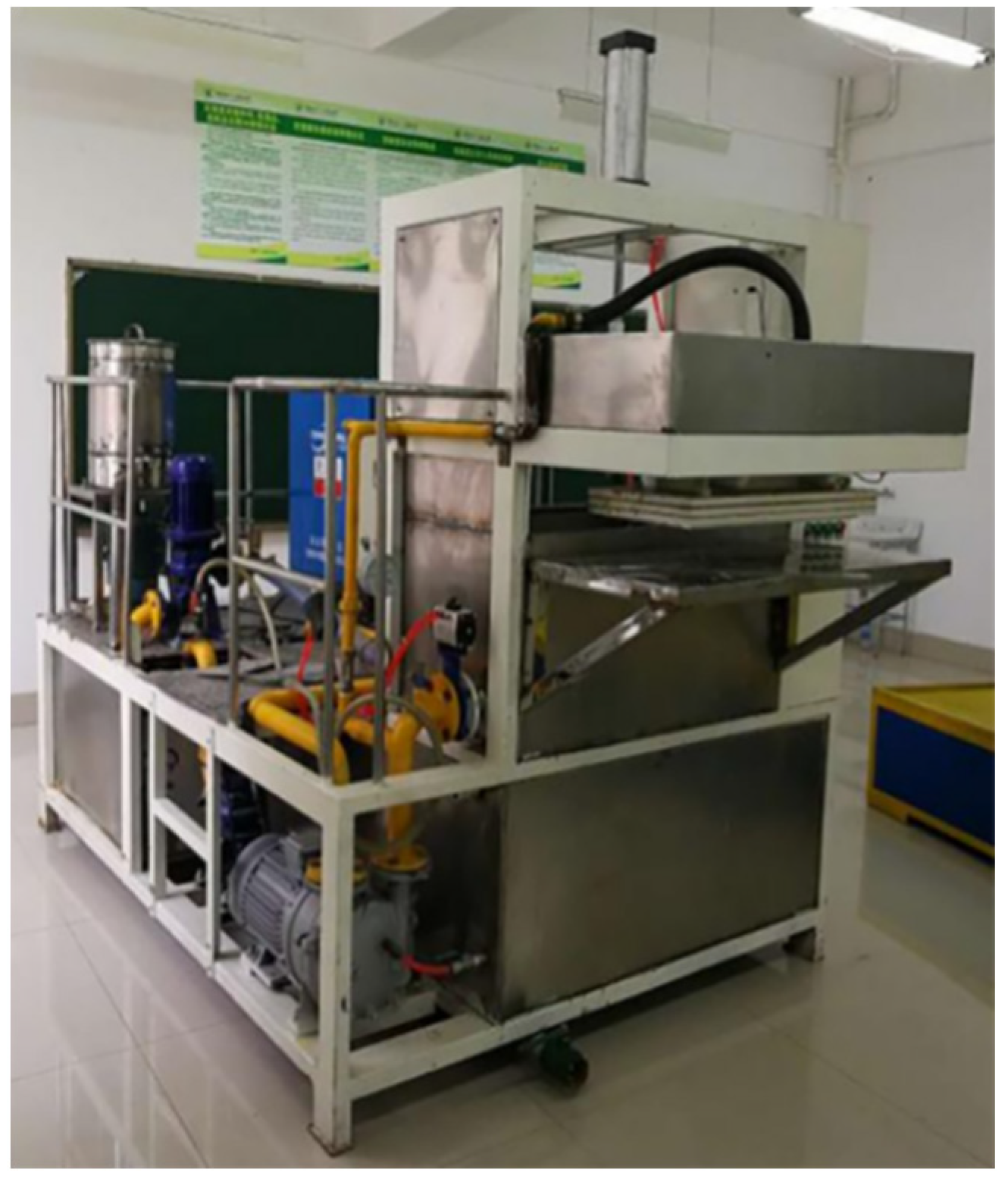

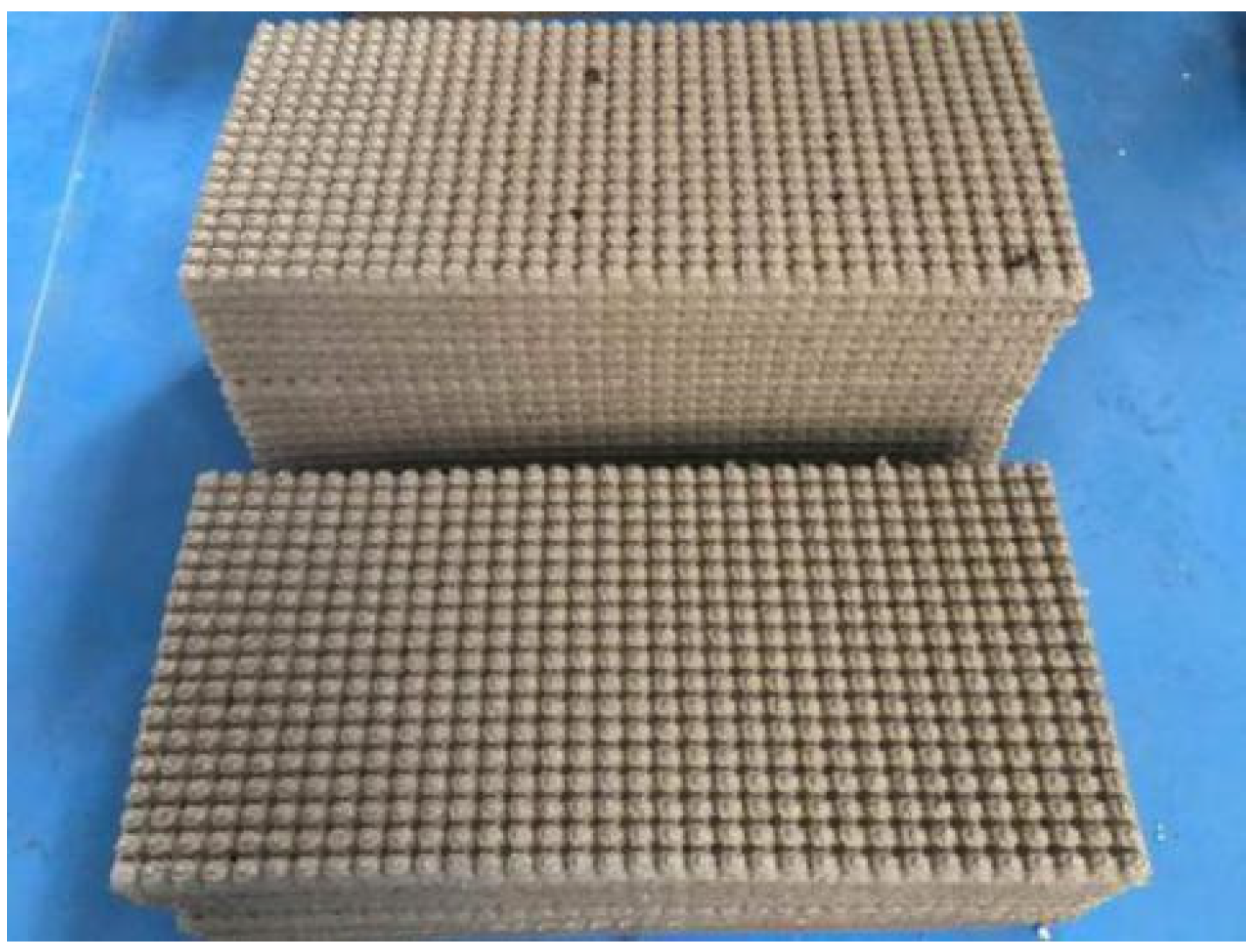
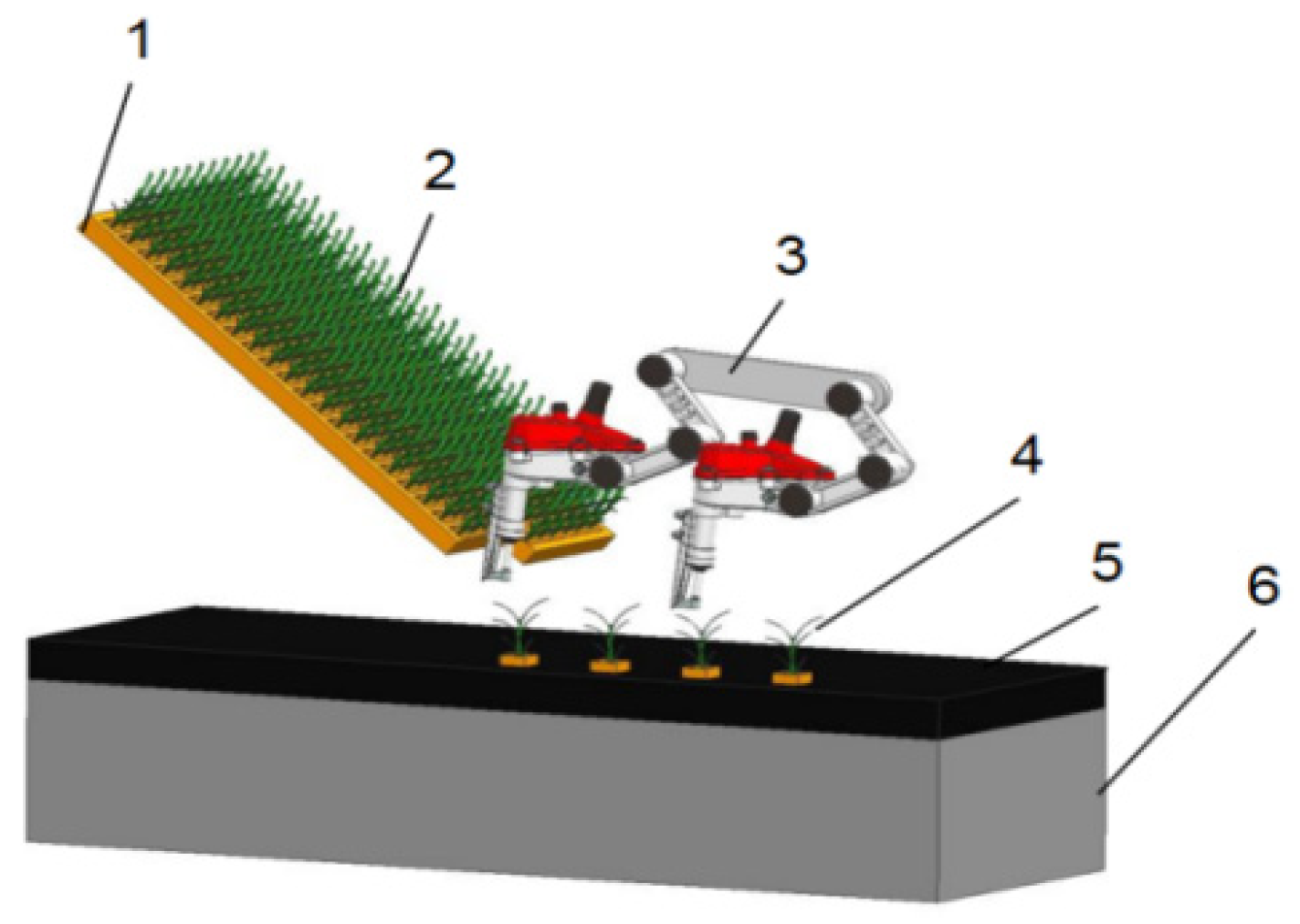
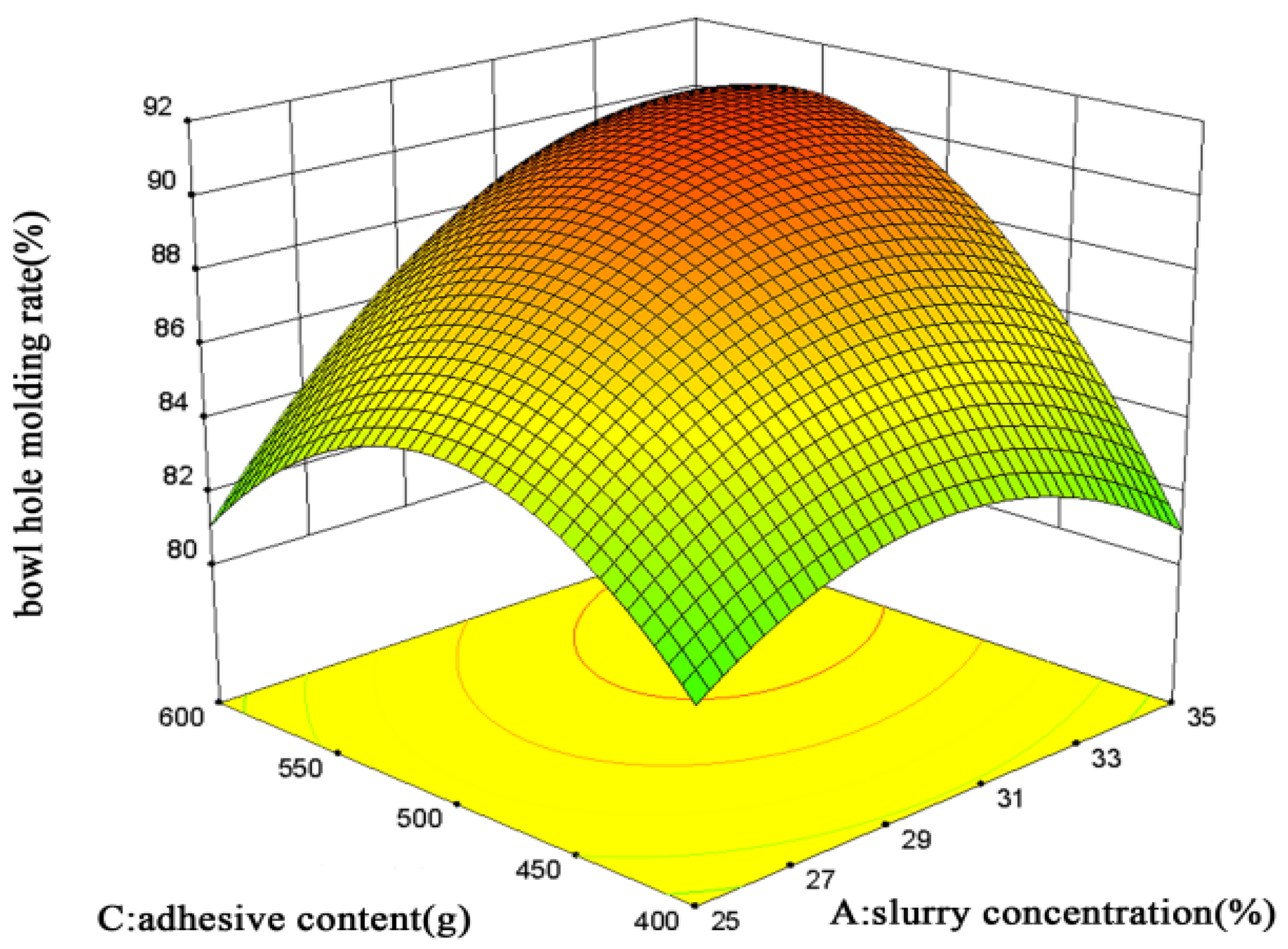


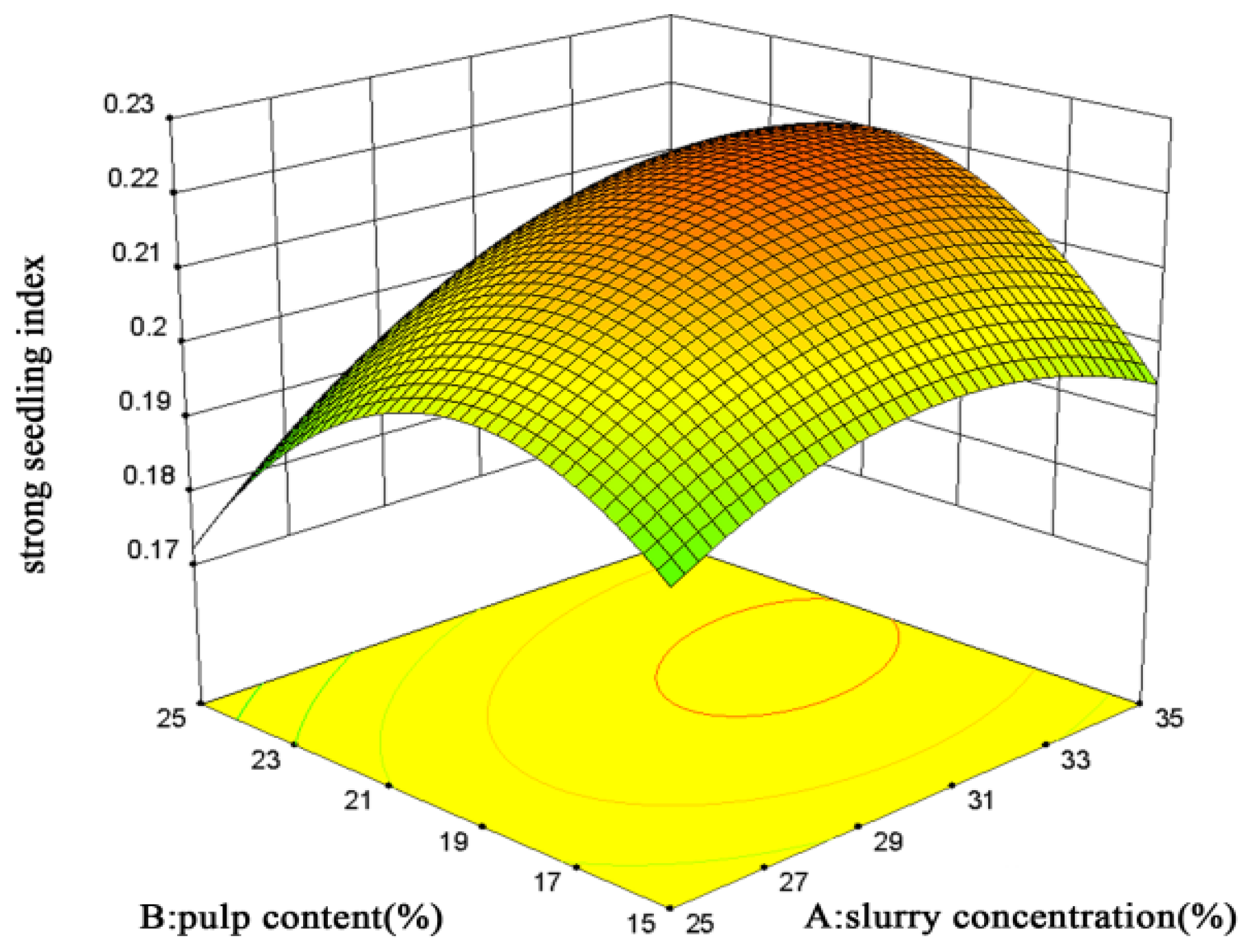
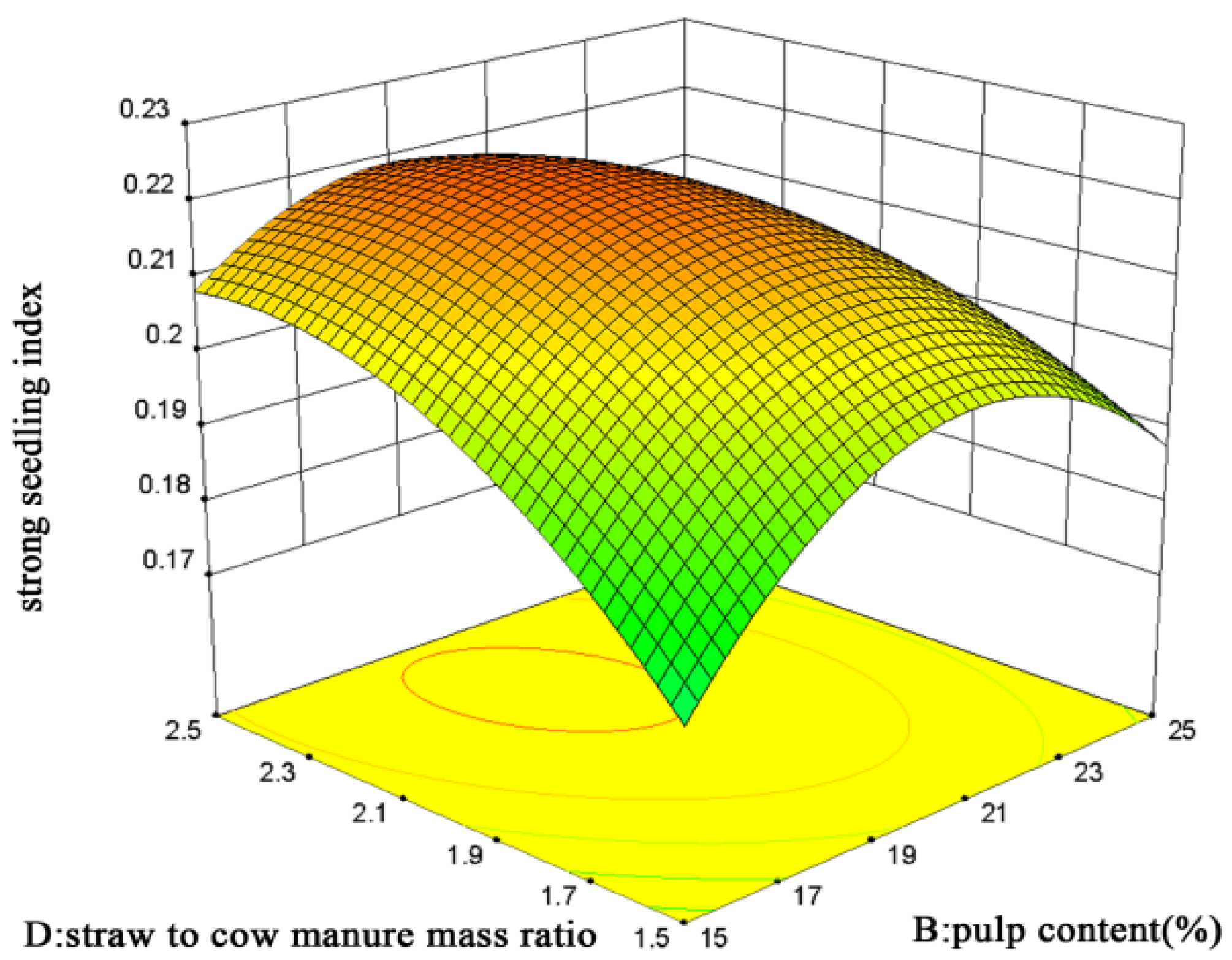
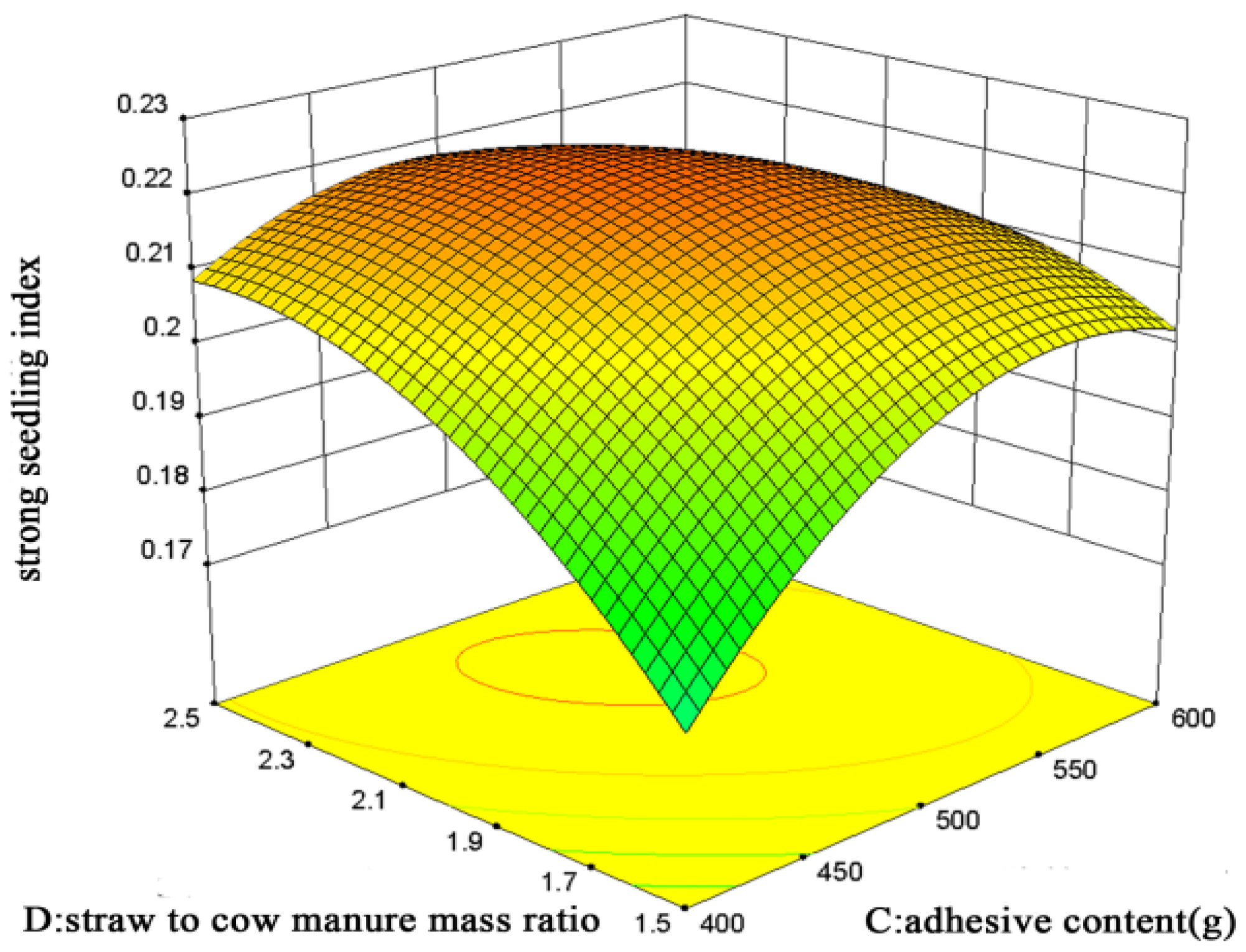
| Materials | Total Nitrogen (g·kg−1) | Total Phosphorus (g·kg−1) | Total Potassium (g·kg−1) | PH | EC (us·cm−1) |
|---|---|---|---|---|---|
| Straw | 8.7 | 1.21 | 16.71 | 8.23 | 1344 |
| Cow manure | 18.03 | 5.02 | 5.49 | 8.05 | 5952 |
| Level | Slurry Concentration x1 (%) | Pulp Content x2 (%) | Adhesive Content x3 (g) | Straw-to-Cow Manure Mass Ratio x4 |
|---|---|---|---|---|
| +2 | 40 | 30 | 700 | 3 |
| +1 | 35 | 25 | 600 | 2.5 |
| 0 | 30 | 20 | 500 | 2 |
| −1 | 25 | 15 | 400 | 1.5 |
| −2 | 20 | 10 | 300 | 1 |
| No. | Experimental Factor | Experimental Index | ||||
|---|---|---|---|---|---|---|
| Slurry Concentration x1 (%) | Pulp Content x2 (%) | Adhesive Content x3 (g) | Straw-to-Cow Manure Mass Ratio x4 | Bowl Hole Molding Rate y1 (%) | Strong Seedling Index y2 | |
| 1 | −1 | −1 | −1 | −1 | 67.2 | 0.14 |
| 2 | 1 | −1 | −1 | −1 | 66.5 | 0.14 |
| 3 | −1 | 1 | −1 | −1 | 66.9 | 0.14 |
| 4 | 1 | 1 | −1 | −1 | 72.7 | 0.18 |
| 5 | −1 | −1 | 1 | −1 | 72.0 | 0.16 |
| 6 | 1 | −1 | 1 | −1 | 83.9 | 0.19 |
| 7 | −1 | 1 | 1 | −1 | 71.0 | 0.15 |
| 8 | 1 | 1 | 1 | −1 | 86.2 | 0.20 |
| 9 | −1 | −1 | −1 | 1 | 84.9 | 0.19 |
| 10 | 1 | −1 | −1 | 1 | 81.7 | 0.18 |
| 11 | −1 | 1 | −1 | 1 | 74.4 | 0.16 |
| 12 | 1 | 1 | −1 | 1 | 76.0 | 0.18 |
| 13 | −1 | −1 | 1 | 1 | 79.5 | 0.18 |
| 14 | 1 | −1 | 1 | 1 | 81.8 | 0.19 |
| 15 | −1 | 1 | 1 | 1 | 69.5 | 0.14 |
| 16 | 1 | 1 | 1 | 1 | 79.3 | 0.17 |
| 17 | −2 | 0 | 0 | 0 | 76.1 | 0.17 |
| 18 | 2 | 0 | 0 | 0 | 80.1 | 0.19 |
| 19 | 0 | −2 | 0 | 0 | 69.6 | 0.13 |
| 20 | 0 | 2 | 0 | 0 | 66.8 | 0.14 |
| 21 | 0 | 0 | −2 | 0 | 67.6 | 0.15 |
| 22 | 0 | 0 | 2 | 0 | 77.4 | 0.17 |
| 23 | 0 | 0 | 0 | −2 | 72.6 | 0.15 |
| 24 | 0 | 0 | 0 | 2 | 81.2 | 0.19 |
| 25 | 0 | 0 | 0 | 0 | 92.3 | 0.21 |
| 26 | 0 | 0 | 0 | 0 | 88.9 | 0.23 |
| 27 | 0 | 0 | 0 | 0 | 88.3 | 0.23 |
| 28 | 0 | 0 | 0 | 0 | 89.8 | 0.22 |
| 29 | 0 | 0 | 0 | 0 | 90.4 | 0.22 |
| 30 | 0 | 0 | 0 | 0 | 89.8 | 0.21 |
| Source of Variation | Bowl Hole Molding Rate y1 | Strong Seedling Index y2 | ||||
|---|---|---|---|---|---|---|
| Sum of Squares | F Value | p-Value | Sum of Squares | F Value | p-Value | |
| Model | 1906.24 | 33.99 | <0.0001 | 0.025 | 21.19 | <0.0001 |
| x1 | 107.90 | 26.94 | 0.0001 ** | 2.090 × 10−3 | 24.77 | 0.0002 ** |
| x2 | 30.79 | 7.69 | 0.0142 * | 9.769 × 10−5 | 1.16 | 0.2989 |
| x3 | 114.02 | 28.46 | <0.0001 ** | 6.106 × 10−4 | 7.24 | 0.0168 * |
| x4 | 137.89 | 34.42 | <0.0001 ** | 1.662 × 10−3 | 19.70 | 0.0005 ** |
| x1x2 | 31.04 | 7.75 | 0.0139 * | 8.266 × 10−4 | 9.80 | 0.0069 ** |
| x1x3 | 79.73 | 19.90 | 0.0005 ** | 5.152 × 10−4 | 6.11 | 0.0259 * |
| x1x4 | 29.30 | 7.31 | 0.0163 * | 4.763 × 10−4 | 5.49 | 0.0212 * |
| x2x3 | 0.076 | 0.019 | 0.8919 | 2.290 × 10−4 | 2.71 | 0.1202 |
| x2x4 | 79.73 | 19.90 | 0.0005 ** | 1.108 × 10−3 | 13.14 | 0.0025 ** |
| x3x4 | 137.70 | 34.37 | <0.0001 ** | 1.548 × 10−3 | 18.35 | 0.0007 ** |
| x12 | 188.64 | 47.09 | <0.0001 ** | 2.356 × 10−3 | 27.93 | <0.0001 ** |
| x22 | 713.90 | 178.21 | <0.0001 ** | 11.018 × 10−3 | 128.24 | <0.0001 ** |
| x32 | 446.56 | 111.47 | <0.0001 ** | 5.229 × 10−3 | 61.99 | <0.0001 ** |
| x42 | 235.26 | 58.73 | <0.0001 ** | 2.968 × 10−3 | 35.19 | <0.0001 ** |
| Residual | 60.09 | 2.68 | 0.1440 | 1.265 × 10−3 | 1.57 | 0.3223 |
| Lack of fit | 50.64 | 9.602 × 10−4 | ||||
| Pure error | 9.45 | 3.053 × 10−4 | ||||
| Sum total | 1966.33 | 0.026 | ||||
| Parameters | Bowl Hole Molding Rate/% | Strong Seedling Index/g·cm3 |
|---|---|---|
| predicted value | 91.03 | 0.22 |
| Mean of tests | 89.47 | 0.19 |
| Relative error/% | 1.7 | 13.6 |
Disclaimer/Publisher’s Note: The statements, opinions and data contained in all publications are solely those of the individual author(s) and contributor(s) and not of MDPI and/or the editor(s). MDPI and/or the editor(s) disclaim responsibility for any injury to people or property resulting from any ideas, methods, instructions or products referred to in the content. |
© 2024 by the authors. Licensee MDPI, Basel, Switzerland. This article is an open access article distributed under the terms and conditions of the Creative Commons Attribution (CC BY) license (https://creativecommons.org/licenses/by/4.0/).
Share and Cite
Li, H.; Wang, H.; Sun, W.; Wang, C.; Sun, H.; Yu, H. Proportion and Performance Optimization of Biomass Seedling Trays Based on Response Surface Analysis. Sustainability 2024, 16, 1103. https://doi.org/10.3390/su16031103
Li H, Wang H, Sun W, Wang C, Sun H, Yu H. Proportion and Performance Optimization of Biomass Seedling Trays Based on Response Surface Analysis. Sustainability. 2024; 16(3):1103. https://doi.org/10.3390/su16031103
Chicago/Turabian StyleLi, Hailiang, Hongxuan Wang, Weisheng Sun, Chun Wang, Haitian Sun, and Haiming Yu. 2024. "Proportion and Performance Optimization of Biomass Seedling Trays Based on Response Surface Analysis" Sustainability 16, no. 3: 1103. https://doi.org/10.3390/su16031103





